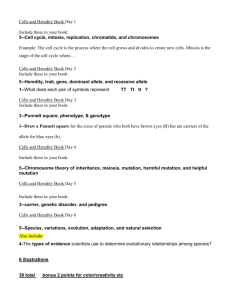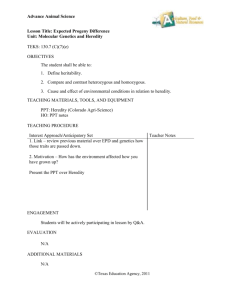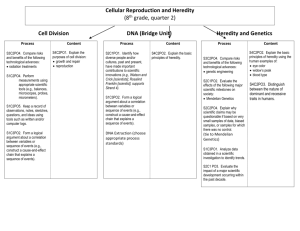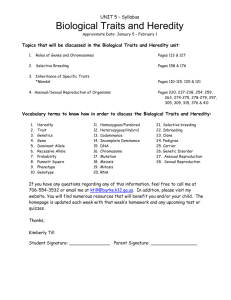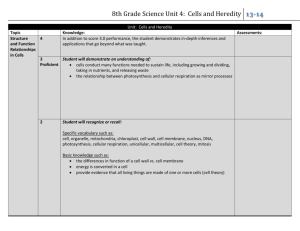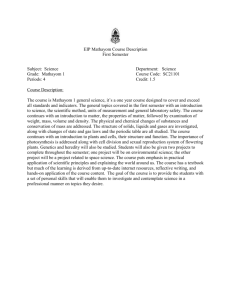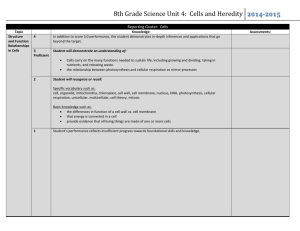SCIENCE CORE CURRICULUM GUIDE
advertisement
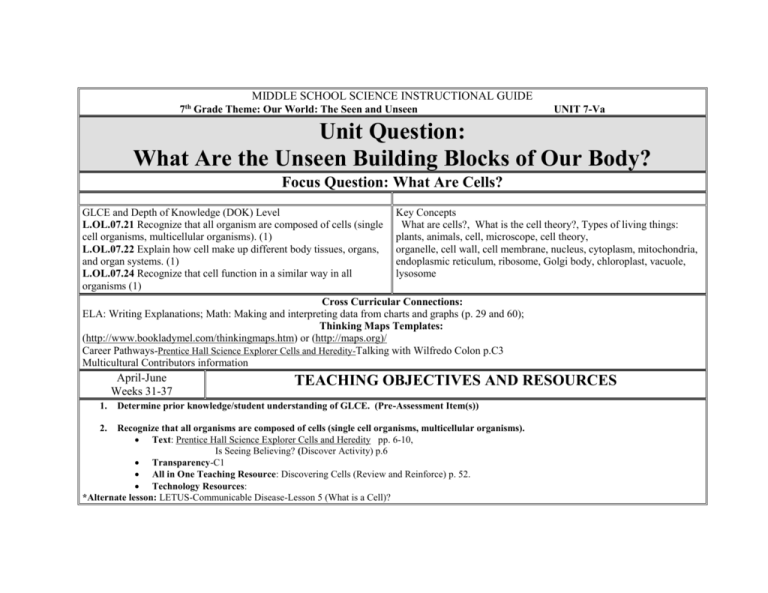
MIDDLE SCHOOL SCIENCE INSTRUCTIONAL GUIDE th 7 Grade Theme: Our World: The Seen and Unseen UNIT 7-Va Unit Question: What Are the Unseen Building Blocks of Our Body? Focus Question: What Are Cells? GLCE and Depth of Knowledge (DOK) Level Key Concepts L.OL.07.21 Recognize that all organism are composed of cells (single What are cells?, What is the cell theory?, Types of living things: cell organisms, multicellular organisms). (1) plants, animals, cell, microscope, cell theory, L.OL.07.22 Explain how cell make up different body tissues, organs, organelle, cell wall, cell membrane, nucleus, cytoplasm, mitochondria, and organ systems. (1) endoplasmic reticulum, ribosome, Golgi body, chloroplast, vacuole, L.OL.07.24 Recognize that cell function in a similar way in all lysosome organisms (1) Cross Curricular Connections: ELA: Writing Explanations; Math: Making and interpreting data from charts and graphs (p. 29 and 60); Thinking Maps Templates: (http://www.bookladymel.com/thinkingmaps.htm) or (http://maps.org)/ Career Pathways-Prentice Hall Science Explorer Cells and Heredity-Talking with Wilfredo Colon p.C3 Multicultural Contributors information April-June Weeks 31-37 1. 2. TEACHING OBJECTIVES AND RESOURCES Determine prior knowledge/student understanding of GLCE. (Pre-Assessment Item(s)) Recognize that all organisms are composed of cells (single cell organisms, multicellular organisms). Text: Prentice Hall Science Explorer Cells and Heredity pp. 6-10, Is Seeing Believing? (Discover Activity) p.6 Transparency-C1 All in One Teaching Resource: Discovering Cells (Review and Reinforce) p. 52. Technology Resources: *Alternate lesson: LETUS-Communicable Disease-Lesson 5 (What is a Cell)? 3. 4. 5. Describe the similarity and difference between animal and plant cell Text: Prentice Hall Science Explorer Cells and Heredity p. 20-21 All in One Teaching Resource: Use Target Reading Skills (Guided Reading and Study) p. 58. Transparency-C3, C4, C5 Technology Resources: Active Art-Plant and Animal Cells (PHSchool.com /Web Code:cep-3012) http://www.cellsalive.com/ -Interactive tour of the Plant, Animal and Bacterial Cell Free PowerPoint Presentations http://science.pppst.com/cells.html - Introduction to the Cell, Plant and Animal Cell, Cell Theory, etc. http://sun.menloschool.org/~cweaver/cells/- Reinforcement of animal and plant cell terms http://www.explorelearning.com/index.cfm (Cells) Free 30 Day Trial for online simulations that power inquiry and understanding http://www.brainpop.com/ (Cells) Free 30 Day Trail for Movie Clip and Quiz Explain how cells make up different body tissues, organs, and organ systems. Text: Prentice Hall Science Explorer Cells and Heredity, pp. 16-22. How Large Are Cells” (Skills Lab)-“ p.16 Transparency-C27 All in One Teaching Resource: Looking inside the cells (Guided Reading and Study) p. 58-60 Looking Inside Cells (Review and Reinforce) p. 61, Modeling Cell Structures (Enrich) p. 61 Technology Resources: Video-Discovery School: Video Explorations, “Cell Structure and Function” PowerPoint Presentations - http://science.pppst.com/cells.html- Cell Structure and Function Recognize that cells function in a similar way in all organisms. Text: Prentice Hall Science Explorer Cells and Heredity, p7, p. 20-23 Thinking Map: Use Double Bubble Thinking Map to compare the functions of animal and plant cell. Graphic Organizer-Flowchart on the cell primary goal Technology Resources: http://www.beyondbooks.com/lif71/4a.asp (A Busy Factory) SAMPLE BELLWORK/DO NOW What do you know about cells? Name the three main parts of a cell? Does an adult have bigger cells than a baby? OR Does and elephant have bigger cells than a mouse? OR Does an evergreen tree have bigger cells than a tulip? Compare and Contrast the two kinds of cells: Eukaryotic and Prokaryotic Why are cells often compared to a factory? List the three parts of the Cell Theory Place some diagrams of specialized cells on the overhead and have the students write what they think the cell’s specialized function is and why? SAMPLE ASSESSMENTS Text: Prentice Hall Cells and Heredity, p.13, Section 1 Assessment, number 1a and 1b Text: Prentice Hall Cells and Heredity, p. 24 Section 2 Assessment Text: Prentice Hall Cells and Heredity, p. 62 Section 3 Assessment Create a Foldable or Graphic Organizer or Thinking Map comparing three types of cells. Create a model or diagram of the two types of cell-Animal and Plant. CPS (quick 5 question review, T/F, multiple choice, verbal, exam view) 3-2-1 Write: 3 things I understand well about cell structure and function 2 things I don’t understand 1 thing I have a question about Have students write an explanation for the following focus questions using claim, evidence and reasoning: How are cells similar? Writing in Science p. C3 MIDDLE SCHOOL SCIENCE INSTRUCTIONAL GUIDE th 7 Grade Theme: Our World: The Seen and Unseen UNIT 7-Vb Unit Question: What Are the Unseen Building Blocks of Our Body? Focus Question: How Are Cells Specialized? GLCE and Depth of Knowledge (DOK) Level Key Concepts L.OL.07.23 Describe how cells in all multicellular organisms are What are elements and compounds? What are the main kinds of specialized to take in nutrients, which they use to provide energy for organic molecules in living things?, osmosis, selectively permeable, the work that cells do and to make the materials that a cell or diffusion, passive, active transport, cell division organisms needs. (2) L.OL.07.32 Examine how through cell division, cells can become specialized for specific functions. (1) Cross Curricular Connections: ELA: Writing Explanations; Math: Making and interpreting data from charts and graphs (p. 29), Thinking Maps Templates: (http://www.bookladymel.com/thinkingmaps.htm) or (http://maps.org)/ April-June TEACHING OBJECTIVES AND RESOURCES Weeks 31-37 6. Describe how cells in all multicellular organisms are specialized to take in nutrients, which they use to provide energy for the work that cells do and to make the materials that a cells or organism needs. Text: Prentice Hall Science Explorer Cells and Heredity, p. 23-24, Transparency: C 11 Technology Resources: http://www.explorelearning.com/index.cfm-Cells (Free 30 Day Trial) Students can watch Osmosis Jones Movie as the complete the worksheet which follows the movie in order http://www.mysciencebox.org/files/osmosis_jones.pdf 7. Active Art-The Cell Cycle activity (Web Code:cep-3023) Examine how through cell division, cells can become specialized for specific functions Text: Prentice Hall Science Explorer Cells and Heredity, pp. 56 8. Describe osmosis role in cells Text: Prentice Hall Science Explorer Cells and Heredity pp. 32-37 Thinking Map:Compare and Contract (Passive transport and Active Transport) Transparency –C8, C9, C 10 All in One Teaching Resource: The Cell In Its Environment (Guided Reading and Study) p. 74-75 The Cell In Its Environment (Review and Reinforce) p. 76 Facilitated Diffusion (Enrich) p. 77 Lab Zone: Egg-Speriment With a Cell Technology Resources: http://www.authorstream.com/presentation/rangerblue-71924-diffusion-osmosis-ii-education-ppt-powerpoint/ www.science-class.net/PowerPoints/Diffusion_osmosis.ppt SAMPLE BELLWORK/DO NOW During the division of Meiosis why do cells become specialized for specific functions. What is the difference between osmosis and diffusion SAMPLE ASSESSMENTS Section 4 Assessment p. 37 Have students write an explanation for the following focus questions using claim, evidence and reasoning: How are cells specialized? MIDDLE SCHOOL SCIENCE INSTRUCTIONAL GUIDE 7th Grade Theme: Our World: The Seen and Unseen UNIT 7-Vc Unit Question: What Are the Unseen Building Blocks of Our Body? Focus Question: How Are Plants Specially Organized? GLCE and Depth of Knowledge (DOK) Level Key Concepts L.OL.07.61 Recognize the need for light to provide energy for the Photosynthesis (process and products of food production and transport), production of carbohydrates, proteins and fats. (2) chemical compounds in cells, plant storage organs (i.e. potato, onion, P.EN.07.43 Explain how light energy is transferred to chemical energy starch storage in plants grown under different conditions, through the process of photosynthesis. (2) autotroph, heterotrophy, pigment, chlorophyll, stomata, respiration, L.OL.07.63 Describe evidence that plants make, use and store food. (3) fermentation,Mitosis, Meisosis, Cell cycle, interphase, replication, L.OL.07.31 Describe growth and development in terms of increase of mitosis, chromosome, cytokinesis, Specialized functions of cellscell number and/or cell size. (1) reproduction, photosynthesis, transport movement, and disease fighting L.OL.07.62 Explain that carbon dioxide and water are used to produce and key concepts on p. 16, carbohydrate, lipid, protein carbohydrates, proteins, and fats. (2) Cross Curricular Connections: ELA: Writing Explanations; Math: Making and interpreting data from charts and graphs (p. 29); Thinking Maps Templates: (http://www.bookladymel.com/thinkingmaps.htm) or (http://maps.org)/ April-June Weeks 31-37 TEACHING OBJECTIVES AND RESOURCES 9. Recognize the need for light to provide energy for the production of carbohydrates, proteins and fats in plants. Text: Prentice Hall Science Explorer Cells and Heredity pp. 27-28, 45 Transparency –C 11 All in One Teaching Resource: Cell processes and energy (Guided Reading and Study) p. 112, Enrich p. 115 Technology Resources: Science Explorer Video Explorations-cell processes and energy http://www.explorelearning.com/index.cfm?method=cResource.dspResourcesForCourse&CourseID=303 (Heredity and genetics) Free 30 Day Trial for online simulations that power inquiry and understanding http://www.brainpop.com/ (Photosynthesis) Free 30 Day Trail for Movie Clip and Quiz 10. Explain how light energy is transferred to chemical energy through the process of photosynthesis. Text: Prentice Hall Science Explorer Cells and Heredity, pp. 46. Transparency – C13 , C 14 All in One Teaching Resource: Cell processes and energy (Guided Reading and Study) p. 112, Enrich p. 115 Technology Resources: Active Art- PHSchool.com (Web Code:cep-1042) 11. Describe evidence that plants make, use and store food. Text: Prentice Hall Science Explorer Cells and Heredity pp. 47 Transparency –C12 Lab Zone: Prentice Hall Science Explorer Cells and Heredity -Looking at Pigment p. 47 All in One Teaching Resource: Chlorophyll and the color of light (Review and Reinforce) p. 114 Technology Resources: Active Art-The Cell Cycle activity (Web Code:cep-3023) 12. Explain that carbon dioxide and water are used to produce carbohydrates, proteins, and fats Text: Prentice Hall Science Explorer Cells and Heredity, pp. 48 What is a Product of Respiration? (Discover Activity ) p. 49; Measuring Carbon Dioxide (Teacher Demo) p. 51 Targeted Print: Color Transparency –C 19 13. Define Respiration and explain the difference between respiration and photosynthesis. Text: Prentice Hall Science Explorer Cells and Heredity, pp. 49-53. Transparency – C15 , C 16, C 16, C 17, C 23 All in One Teaching Resource: Respiration (Guided Reading), pp.127-130, Respiration-(Review and Reinforce) p. 121 14. Describe growth and development in terms of increase of cell number and/or cell size. Text: Prentice Hall Science Explorer Cells and Heredity pp. 55-56 Thinking Map (Sequencing Map for the Cell Cycle p. 55) Transparency –C18, C 19 All in One Teaching Resource: Discover Activity-What Are the Yeast Cells Doing? Modeling Mitosis (Try this activity) p. 56 Technology Resources: Active Art-The Cell Cycle activity (Web Code:cep-3023) PowerPoint Presentations- http://www.pbs.org/wgbh/nova/baby/divide.html# (How Cells Divide: Mitosis vs. Meiosis) http://www.explorelearning.com/index.cfm?method=cResource.dspResourcesForCourse&CourseID=303 (Heredity and genetics) Free 30 Day Trial for online simulations that power inquiry and understanding http://www.brainpop.com/ (Heredity) Free 30 Day Trail for Movie Clip and Quiz SAMPLE BELLWORK/DO NOW What do plants need to grow? Explain how light energy is transferred to chemical energy through the process of photosynthesis Describe how plants make and store food. Explain the events that occur during photosynthesis. Hint: Use the chemical equation for photosynthesis to help. What do you predict would happen to a plant that did not receive any light? Describe how cell grow and develop during Mitosis? Place the main phases of Mitosis in its correct order: Telophase, Interphase, Anaphase, Prophase, and Metaphase During what phase of mitosis does cytokinesis begin? Explain the difference between Mitosis and Meiosis SAMPLE ASSESSMENTS Text: Prentice Hall Cells and Heredity: Section 1 Assessment p.48 Writing in Science p. 48 Create a Foldable for two stages of photosynthesis Sequencing Chart for steps in Photosynthesis CPS (quick 5 question review, T/F, multiple choice, verbal, examview) Have students write an explanation for the following focus questions using claim, evidence and reasoning: How are cells similar? Text: Prentice Hall Cells and Heredity: Section 3 Assessment p.62-1a, 1b, 1c Writing in Science p. 62 Create a Foldable for mitosis and meiosis CPS (quick 5 question review, T/F, multiple choice, verbal, examview) Design and conduct a scientific investigation that demonstrates the role of mitosis and meiosis in a plant or animal cell MIDDLE SCHOOL SCIENCE INSTRUCTIONAL GUIDE th 7 Grade Theme: Our World: The Seen and Unseen UNIT 7-Vd Unit Question: What Are the Unseen Building Blocks of Our Body? Focus Question: How Do Living Things Reproduce? GLCE and Depth of Knowledge (DOK) Level L.HE.07.21 Compare how characteristics of living things are passed on through generations, both asexually and sexually. (2) L.HE.07.22 Compare and contrast the advantages and disadvantages of sexual vs. asexual. (2) Key Concepts Hereditary information, Traits-inherited, acquired, Data on heredity (such as identical twin studies, effects of introduced toxins, effects of controlled selection and breeding, Reproductive cells-egg, sperm, gametes. chromosome, gene, heredity, trait, genetics, fertilization, purebred, gene, alleles, dominant allele, recessive allele, hybrid, asexual reproduction, sexual reproduction Cross Curricular Connections: ELA: Writing Explanations; Math: Making and interpreting data from charts and graphs Prentice Hall Science Explorer Cells and Heredity p. 88, How to calculate percentage. p. 85 Thinking Maps Templates: (http://www.bookladymel.com/thinkingmaps.htm) or (http://maps.org)/ April-June Weeks 31-37 TEACHING OBJECTIVES AND RESOURCES 15. Compare how characteristics of living things are passed on through generations, both asexually and sexually. Text: Prentice Hall Science Explorer Cells and Heredity pp. 76-81 Transparency –C 26, C 33 Science Explorer Video Explorations, “Genetics: The Science of Heredity ” Lab Zone: Heredity Lab All in One Teaching Resource: Guided Reading, pp.1175-177, Skills lab 180, Enrich 198. Compare how characteristics of living things are passed on through generations, both asexually and sexually (continued). Technology Resources: Active Art-The Cell Cycle activity (Web Code:cep-3023) Laser Disc-Science Sleuth “The Ballad of Bobby Ray” PowerPoint Presentations- http://science.pppst.com/dna.html http://www.genetics.gsk.com/kids/factoids_kids/ (Recognize that genetic information is passed from parent to offspring during reproduction). http://www.usoe.k12.ut.us/curr/science/sciber00/7th/genetics/sciber/genetic2.htm (Are you my mommy?-Heredity Lesson Plan for Teachers) http://www.explorelearning.com/index.cfm?method=cResource.dspResourcesForCourse&CourseID=303 (Heredity and genetics) Free 30 Day Trial for online simulations that power inquiry and understanding http://www.brainpop.com/ (Heredity) Free 30 Day Trail for Movie Clip and Quiz 16. Compare and contrast the advantages and disadvantages of sexual vs. asexual. Text: Prentice Hall Science Explorer Cells and Heredity, pp. 110-11, 116, 123-127, 138-147 Transparency C 40 Graphic Organizer- Compare and contrast the advantages and disadvantages of sexual vs. asexual. Lab Zone: Acquired Traits Lab, Natural Selection Lab Technology Resources: PowerPoint Presentations- http://science.pppst.com/dna.html SCiLinks-www.SciLinks.org-(web code:scn-0341) SAMPLE BELLWORK/DO NOW Using what you know about cell structure, predict the location of hereditary materials within the cell. Which of the following are examples of sexual reproduction and which are asexual forms? (a bacterium divides into two bacteria, a bear cub is born to a mother bear, a bee pollinates an apple blossom, a pine sapling is growing from a seed) Greogor Mendel made many discoveries about genetics working with pea plants. He found that a round shape was a dominant trait and a wrinkled shape was a recessive trait. What offspring would you expect from a cross of two wrinkled pea producing plants? Answer-All offspring would produce wrinkled peas. SAMPLE ASSESSMENTS Write an explanation: Describe how the characteristics of living things are passed on through generations. Create a Foldable for mitosis and meiosis CPS (quick 5 question review, T/F, multiple choice, verbal, examview) Section 3 Assessment p. 96, number 2a-c Make a Venn diagram of sexual vs. asexual reproduction Compare and contrast the advantages and disadvantages of sexual vs. asexual Have students write an explanation for the following focus questions using claim, evidence and reasoning: How do living things reproduce?

